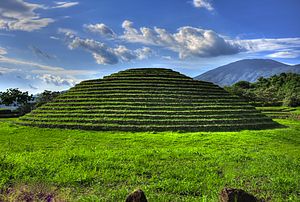 Global Information
Global InformationGuachimontones information
 "La Iguana" structure. | |
 Location within Mesoamerica | |
| Location | Jalisco, Mexico |
|---|---|
| Region | Jalisco |
| Coordinates | 20°40′59.00″N 103°49′0.00″W / 20.6830556°N 103.8166667°W |
| History | |
| Periods | Late Formative to Classic |
| Cultures | Teuchitlán culture |
| Site notes | |
UNESCO World Heritage Site | |
| Official name | Agave Landscape and Ancient Industrial Facilities of Tequila |
| Criteria | Cultural: ii, iv, v, vi |
| Reference | 1209 |
| Inscription | 2006 (30th Session) |
Los Guachimontones is the largest Late Formative to Classic period (300 BCE to 450/500 CE) pre-Columbian archaeological site in the state of Jalisco.[1] Situated in the hills above the town of Teuchitlán that provides the namesake for the culture that built the site, Los Guachimontones is part of the Agave Landscape and Ancient Industrial Facilities of Tequila UNESCO world heritage site and a major tourist attraction within the Tequila Valleys.
Los Guachimontones is one of several dozen Teuchitlán Culture sites within the Tequila Valleys, though it is by far the largest site in terms of both the number and size of its ceremonial buildings. These buildings, called guachimontones (singular, guachimontón) after the site name, are bulls-eye shaped buildings consisting of several distinct architectural elements that constitute a whole structure. These unique buildings are found primarily in the Tequila Valleys with other examples found in northern Jalisco near Bolaños,[2][3] Guanajuato[4] to the east, and Colima[5] to the south.
The Teuchitlán culture that built the site was one of several cultures in West Mexico during the Late Formative to Classic periods that participated in the shaft tomb tradition in which some, but not all, people were interred underground.[6] Sometimes mortuary goods accompanied the deceased with objects such as ceramic vessels, hollow and solid figurines, shell ornaments, conch shell trumpets, jadeite, and ground stone objects.[7][8]
While Los Guachimontones was founded in the Late Formative period, there is some evidence of a Middle Formative occupation suggesting some temporal continuity at the site. Major construction began in the Late Formative and continued into the Early Classic. Monumental construction appears to have tapered off in the Late Classic with a decline in population followed by a drastic decline in the Epiclassic. Population levels rebounded to their Early Classic levels in the Postclassic, but with no monumental construction at or near the site.[1]
- ^ a b Christopher S. Beekman (2018). La secuencia cronológica temprana en Los Guachimontones. In Nuevos enfoques en la arqueología de la región de Tequila: Memoria de la Primera Catedra Phil C. Weigand, edited by Joshua D. Englehardt and Verenice Y. Heredia Espinoza, pp. 83-127. Colegio de Michoacán, Zamora, Michoacán, México.
- ^ Maria Teresa Cabrero Garcia (1989). Civilización en el norte de México: Arqueología de la cañada del Rio Bolaños (Zacatecas y Jalisco). Universidad Nacional Autónoma de México, México City.
- ^ María Teresa Cabrero García (1991). Cultura arqueológica de Bolaños (Zacatecas y Jalisco): Una frontera cultural. Ancient Mesoamerica 2(2): 193-203.
- ^ Efraín Cárdenas García (1999). El Bajío en el clásico: análisis regional y organización política. El Colegio de Michoacán, Zamora, México.
- ^ María de los Ángeles Olay Barrientos and Ligia Sofia Sánchez Morton (2015). La Tradición Teuchitlán en Colima, notas para una discusión. Revista Occidente.
- ^ Christopher S. Beekman and Robert B. Pickering (2016). Introduction: An Historical Overview of Shaft Tomb Archaeology in Western Mexico. In Shaft Tombs and Figures in West Mexican Society: A Reassessment edited by Christopher S. Beekman and Robert B. Pickering, pp. 1-21. Gilcrease Museum/Thomas Gilcrease Institute of American History and Art.
- ^ Jorge Ramos de la Vega and M. Lorenza López Mestas Camberos (1996). Datos preliminares sobre el descubrimiento de una tumba de tiro en el sitio de Huitzilapa, Jalisco. Ancient Mesoamerica 7(1): 121-134.
- ^ Lorenza López Mestas Camberos and Jorge Ramos de la Vega (2006). Some Interpretations of the Huitzilapa Shaft Tomb. Ancient Mesoamerica 18: 271-281.